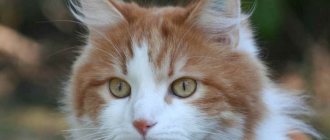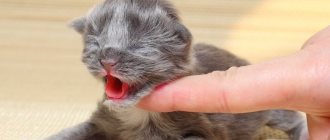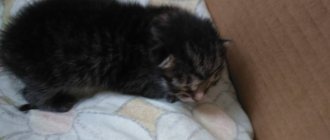The most common question that owners ask is why does a cat bleed from the genital tract? There are several reasons for this phenomenon. How to determine which discharge is normal, and which ones require the patient to be taken to the clinic immediately? What danger lies in the beginning of bleeding during pregnancy?
What is considered normal?
Even a nulliparous cat produces clear mucus during estrus, which is normal and does not pose a threat to health. After mating, pink discharge may appear. These are unfertilized eggs that are released from the uterus. Moreover, the inclusions that occur during this period can be red or brown, outwardly similar to elongated veins. This process is also considered normal and indicates that in the uterus of a pregnant cat the flora is sterile and inflammation is completely absent.
Until the end of the 3rd week, clear or transparent white discharge may appear. These are the remains of the mucus plug coming out of the uterine loop. Until the 6th week there should be no discharge, but sometimes you can notice how a white liquid without odor or other inclusions comes out from under the tail. This is excess amniotic fluid, and the situation itself does not pose a threat to the health of the pet. In late stages and at the beginning of labor, you can expect mucous discharge, indicating that one fetus has already begun to move through the birth canal.
When a cat’s bleeding during pregnancy is abundant and has an unpleasant odor, this directly indicates pathological processes that, if left unattended, are dangerous for the life of the pet and the offspring.
Types of discharge and reasons for their appearance
If an animal has damage to the tissue of the uterus itself, then it develops hematuria.
- Bright red. Such discharge in a pregnant cat is always a bad sign. If after 10 min. liquid has not stopped coming out from under the tail, and the total volume exceeds 1-2 tbsp. i.e., this is full-fledged bleeding. During pregnancy, a common cause of bleeding is damage to the uterine tissue. In such situations, there is often blood in the urine.
- Brown. If, 8-9 weeks after conception, a cat has bloody, brown fluid flowing from the genitals, placental abruption may have occurred. In such a situation, the veterinarian will advise monitoring the cat; the last resort is a cesarean section or induction of labor.
- Greenish. Cloudy, white-green discharge with a foul odor is an almost guaranteed sign that one or more fetuses have died in the cat's womb. The situation threatens severe intoxication and gradual impairment of kidney function.
- With pus. Purulent discharge of fawn, green or yellow color indicates the progression of an inflammatory complication. In such situations, the veterinarian most often induces artificial labor in the cat, otherwise the pus may spread to the internal organs, causing sepsis.
Why is it dangerous?
The development of pathogenic bacterial flora is one of the serious complications of a pet’s condition. Bloody, green, yellow discharge during pregnancy is always a pathological sign, indicating some kind of disorder within the body of a pregnant cat. If this condition is not treated, the discharge will not stop flowing on its own. Depending on the causes of the pathology, the risk of the following complications increases:
- complete placental abruption and premature birth;
- intrauterine death of kittens and termination of pregnancy;
- necrosis of tissue of the uterus and other organs;
- the addition of a bacterial infection and its spread;
- impaired renal function;
- death of a cat from complications.
What to do if a pregnant cat is bleeding?
Bloody discharge during pregnancy indicates the development of pathology. Bleeding can be caused by placental abruption, kitten death, or uterine rupture.
If the event occurred before the 63rd day of pregnancy, and it is determined that the offspring has died, measures are taken to save the cat’s life, a cesarean section is performed.
In this case, castration is recommended, since there is a high probability of purulent damage to the reproductive organs.
When bleeding after the onset of contractions continues for more than 10 minutes, and blood loss is more than 2 tablespoons, you need to immediately take the cat to the clinic or call a veterinarian at home. If the birth went well, you should not be afraid of the release of blood clots mixed with mucus. Cleansing can last about two days.
Rectal injuries
Bleeding from the rectum in these animals is accompanied by staining of the stool with scarlet blood. The most common cause of this phenomenon is damage to the mucous membrane of the organ by too hard feces, which contain the remains of incompletely digested food, hair that got into the stomach during licking, and bone fragments. In older pets, this problem can arise as a result of various pathologies of the rectum (for example, prolapse, cracks, malignant neoplasms).
Treatment for pathology
When contacting the clinic, the animal undergoes a series of tests, including ultrasound diagnostics and a clinical examination of the cat. Bleeding in cats poses a serious threat to the life of the pet. This is due to the fact that during the gestation of kittens, the uterus increases in size and is unusually supplied with blood.
In pathological processes (ruptures of the uterine walls, damage to large vessels), the animal quickly loses a large amount of blood and dies without timely help.
Depending on the established diagnosis, the specialist prescribes further treatment, including surgical intervention (if it is not possible to save the kittens) or maintenance therapy using anti-inflammatory drugs and antibiotics.
After any delivery, an animal with pathology needs maintenance therapy to quickly restore vitality.
Preventive measures during cat pregnancy to avoid the appearance of discharge from the loop imply organizing proper nutrition for the animal, both before and during pregnancy. It is recommended to protect the cat from hypothermia and infectious diseases (deworming and vaccination are an integral part of the prevention of animal health).
The manifestation of any signs of ill health of your furry pet is a reason to consult a veterinarian. It is important to make sure that the health of the cat and her babies is not in danger.
Diagnostic measures
If suspicious discharge appears in a cat before or before birth, it is necessary to take the pet to the veterinary clinic as soon as possible, where it will be examined by a veterinarian. The doctor will determine the nature of the discharge, whether it is pus, blood, ichor or transparent white mucus. Pink discharge without other inclusions in the early stages of pregnancy is considered normal; if the cat feels well and is not worried, then there is nothing to worry about. It’s another matter when there is bleeding from the genitals, with blood flowing or dripping constantly, the animal feels bad, is worried, or, conversely, is lethargic and passive. Then a referral is given to the following diagnostic methods:
- general blood and urine analysis;
- microbiological examination of secretions;
- Ultrasound.
Red bleeding after mid-pregnancy
But, if your pregnant cat develops reddish blood spots during the late stages of pregnancy or at the end, then it is likely that she will go into labor. So, if there is a week left in the pregnancy, the birth will occur prematurely, but if it has already occurred in the days close to the completion of the pregnancy process, then there is no need to worry as it will happen at the appropriate time.
If it is in advance, it is best to contact our veterinarian to check our pet and monitor the delivery process, in which some kittens will likely come out smaller than usual.
Likewise, to know that a cat is giving birth, another indicator that will indicate that the time has come is that mucus appears along with a little bleeding, that is, the female will dislodge the mucus plug, which is equivalent to the water breaking in women.
© shutterstock
Tumor formations in the intestines
The appearance of blood from the pet's anus is one of the symptoms of neoplasms in the intestines. Such tumors are rarely diagnosed in cats and often have a poor prognosis. The sooner the cat's owner seeks veterinary help, the higher the likelihood of successful treatment of the animal. The causes of this disease are not fully understood. In the course of research, it was possible to establish that representatives of the Siamese breed have a predisposition to intestinal cancer.
Most often, these animals have such types of formations as nutritional lymphoma, intestinal adenocarcinoma and mastocytoma. The disease is accompanied by the following symptoms:
- loss of appetite;
- weight loss;
- nausea and vomiting;
- stomach ache;
- pallor of the mucous membranes;
- lethargy, apathy;
- bloody diarrhea.
Can a cat be given Oxytocin after giving birth?
In the last century, Oxytocin was a fairly common drug used after childbirth. At the moment it is considered somewhat outdated, however many veterinarians use it very successfully. This drug stimulates contractions, but it is not recommended for use either immediately before birth or at the time of labor resolution, because the animal may have uterine rupture against this background. Oxytocin is widely used during the expulsion of the placenta, that is, when all the babies are born.
If the owner has given Oxytocin and the pet is bleeding brightly, then this is a clear sign of uterine rupture. In this case, the cat must be taken to the veterinarian as quickly as possible. If the bleeding is dripping, then a hemostatic drug can help in this situation. When the discharge is abundant, nothing will help her except surgery.
How to treat?
The owner needs to be close to the pet at such an important moment and monitor so that no complications occur.
Clear, light pink bleeding before childbirth is considered normal, so treatment is not required. The owner needs to monitor the pet’s condition, calm her down during childbirth, and do everything to ensure that the process ends safely. At the same time, during childbirth, it is important to pay attention to the nature of the amniotic fluid, color, and smell. If you have any suspicions, it is better to tell everything to the veterinarian, who will refer you for additional examination and, if necessary, prescribe restorative treatment. In case of uterine abruption, when bloody discharge comes from under the tail, the doctor first of all takes into account the timing of pregnancy. In the later stages, constant monitoring is carried out, and comprehensive analyzes are carried out. Delivery usually occurs without complications unless the animal has other health problems. If abruption occurs in the first half of pregnancy, and the bleeding is profuse, there is no other choice but to artificially induce labor, since the cat may die.
No less dangerous than bloody discharge are purulent discharges, which are often the result of the death and decomposition of one or more fetuses. In such situations, the veterinarian prescribes effective antibiotics and other drugs to avoid complications. If the condition does not return to normal, the doctor will suggest a cesarean section or termination of the pregnancy to save the animal’s life. After surgical treatment or urgent induction of labor, long-term rehabilitation under the supervision of a physician will be required.
Precursors of childbirth and symptoms of an imminent birth of a cat...
External manifestations of imminent labor are called precursors and are similar in dogs and cats.
- Animal behavior,
- lactation,
- appetite,
- frequent urination,
- prolapse of the abdomen,
- loop softening,
- thermometry.
A week before giving birth, the animal’s behavior changes
. This is due to the growth of the hormone estrogen, which causes contraction of the muscle fibers of the uterus (contraction). This increases anxiety and stimulates the animal to build a nest. Dogs begin to dig, cats begin to build a “nest.” It is recommended to provide the animal with a box or house in which it will feel safe.
Lactation
– does not always appear and not for everyone. This is not a completely accurate sign of the harbingers of labor. In some dogs it may appear from the 40th day of pregnancy, and in others only after birth.
Appetite.
In general, the appetite before birth worsens, or may become selective, that is, the animal may become more picky about food.
There are animals that eat even during the birth process, but these are exceptional cases, of course. And some people completely lose their appetite before giving birth, which is a very bad symptom and can lead to ketoacidosis
. If the animal does not eat for more than a day, and labor does not begin, you should consult a doctor. So, everything is individual.
Frequent urination
– normal before labor, usually associated with increased uterine contractions. Urinating in inappropriate places can be an involuntary leakage of urine. Sometimes the animal simply does not have time to “run” or wait until the walk.
«Abdominal prolapse
“- is considered perhaps the surest sign of imminent labor, but it is associated not with the harbingers of labor, but with an increase in the weight of the fetus. The most active weight gain occurs in the last weeks, and the growth of babies continues until the very birth, so the stomach drops under the gravity of the uterus. The more fetuses there are, the more pronounced the prolapse of the uterus is. If the animal has only one fetus, then uterine prolapse may not be noticeable at all.
Loop softening
– she is preparing for childbirth, so she becomes softer and more pliable a couple of days before giving birth.
One of the most accurate precursors of labor is Thermometry
. It is of key importance in determining the period of labor.
For control, it is advisable to measure the temperature 1-2 times a day, starting from the 55th day of pregnancy. When we know what it usually is, we can determine when they will start. A drop in temperature by 2 degrees (to 37) usually indicates the imminent onset of labor.
Physiology of childbirth
In ripened fetuses, cortisol (stress hormone) is formed, which passes the placental barrier, it stimulates the mother’s production of prostaglandins. Prostaglandins dissolve the corpus luteum of pregnancy, which produces the pregnancy hormone progesterone. The amount of progesterone drops sharply and labor begins.
In addition, the amount of estrogens increases, which increases the sensitivity of receptors to oxytocin. The contraction of the uterus increases. The hormone relaxin, produced by the placenta, stimulates the dilatation of the cervix and prepares it for the expulsion of the fetus.
Inflammation of the pancreas
Bleeding from the anus in a cat can be caused by pancreatitis, which develops due to cholelithiasis, pathologies of the duodenum, infections, malnutrition, helminthic infestation, etc. This disease can be recognized by the following signs:
- abdominal pain that gets worse when eating;
- “idle” urge to vomit;
- complete or partial loss of interest in food;
- belching;
- excessive accumulation of gases in the intestines;
- constipation alternating with diarrhea;
- yellowness of the skin and mucous membranes.
In advanced cases, severe disturbances of carbohydrate metabolism join the pathological process. If this happens, it is unlikely that you will be able to avoid developing diabetes.
Precautionary measures
Simple precautions will help to significantly reduce the risk of bleeding in a cat during pregnancy and carry her healthy offspring. For this it is important:
- Prepare the body for conception with a balanced diet and vitamin supplements to support immunity (after consultation with a veterinarian).
- Get your required vaccinations on time.
- Avoid active and active games during pregnancy, during which injury to the abdominal area is possible.
- Ensure a comfortable room temperature and absence of drafts.
- Give your cat enough attention to notice changes in behavior and health in time.
Veterinarian advice for bleeding in a pregnant cat: video
Preventive methods
It is important to show the animal to the doctor in time so that it can carry to term and give birth to offspring normally.
When the owner finds out that his pet is pregnant, he is very happy and tries to do everything for the cat so that this period passes safely and healthy kittens are born. However, sometimes a cat's pregnancy does not go smoothly. In such a situation, it is important to react in time and contact a veterinarian, who, based on the diagnostic results, will advise what to do next. As a preventative measure, it is recommended to always monitor your cat’s health, vaccinate on time, carry out deworming, and treat viral and infectious diseases. In addition, periodic preventive examination of the animal will not hurt. When pregnancy occurs, it is important to carefully monitor the condition of the pet, monitor its behavior, quality of nutrition, and physical activity. You definitely need to listen to the veterinarian’s advice, try to properly care for your cat, and protect it from stress. If the maintenance and care are correct, the cat usually safely carries the kittens to term, and the birth takes place without complications.
Hormones prolactin and lactation hormone
The hormone prolactin is a “maternal behavior” hormone and a lactation hormone.
Stages of childbirth in detail.
Childbirth is divided into 3 stages, each stage has its own time interval.
The intervals and duration of labor are unpredictable, and past births are not an indicator. One time an animal can give birth in a couple of hours, another time the birth will last almost a day and both options can be the norm.
Stage 1 – harbingers of labor.
This is the most painful stage for the animal and the owner. Behavior changes as the uterus contracts, but we do not see this in the abdomen. The dog (cat) is breathing heavily and digging or making a nest. The period can take up to a day. To confirm the onset of labor in dogs, a progesterone test can be done. Its decrease confirms the onset of labor.
Exception: In cats, progesterone is also produced by the placenta, so the drop in progesterone will not be as significant as in dogs. A strong decrease in cats occurs only the day after birth.
Similarly, in the case of “single puppy/kitten syndrome”, one fetus may not cause such a cascade of reactions, as a result of which pregnancy may be delayed. And there is no decrease in temperature, since progesterone does not drop and labor does not begin for a long time.
Prevention
In order for the process of bearing offspring in your animal to go smoothly, it is important to carry out preventive measures in a timely manner. Moreover, it is better to carry out some of them not at the moment when mating occurs, but throughout the entire life of the animal.
Monitor the animal’s health, get all the necessary vaccinations on time and select the right food, taking into account all the parameters. It would also be a good idea to have periodic checkups with a veterinarian.
After mating, you should carefully monitor the condition of the animal and pay attention to even the smallest changes.
- All the veterinarian's instructions must be followed very carefully.
- During pregnancy, you should protect your pet from cold, drafts and dampness.
- For mating, you should choose a healthy partner who has all the necessary vaccinations.
It is important that mucous discharge can also appear in a sterilized cat a short time after surgery. They have a slimy consistency and yellow color, but do not have a strong odor. If such discharge does not stop for a long time, then you should show your pet to a veterinarian, as inflammatory processes are likely to develop.
Proper care and following all doctor’s recommendations will help your cat have a normal pregnancy and give birth to healthy kittens. It is important for the owner only to pay attention to the condition of the pet, and everything else will happen by itself.
This article has been checked and approved by a veterinarian. Knyazeva Anna Vladimirovna, veterinarian in private practice, Moscow. more about the expert.
(you can vote for the article)
Tags: cat pregnancy, cat discharge, cat
- Related Posts
- Umbilical cord in kittens: how to help a cat separate it?
- Sphynx Bambino: an unusual breed of cat!
- Yorkie dog breed. Types of Yorkies
Causes of bleeding
A pregnant cat may bleed in small quantities or profusely. In the first case, owners often do not notice this phenomenon, paying attention only to possible accompanying symptoms (lack of appetite, lethargy, apathy, depression, wet fur, frequent licking of the area around the tail and an anxious mood).
Owners usually notice heavy bleeding in a pregnant cat immediately. This phenomenon can be a symptom of various pathologies, including:
- Inflammation of the urinary or reproductive systems.
- Miscarriage occurring as a result of chronic diseases of internal organs, unbalanced nutrition, injury or abnormalities of the fetus.
- Injury to the uterus, which can occur after jumping, falling or hitting. In this case, the risk of death of the offspring is extremely high.
- Frozen pregnancy, which is a consequence of genital infections, placental insufficiency, developmental abnormalities of the offspring and other serious pathologies.
- Placental abruption. In this case, in the early stages, kittens have practically no chance of survival. After 8 weeks, the likelihood of saving the offspring increases greatly.
- Natural selection. More often in early, but sometimes also in late stages of pregnancy, the body rejects a fetus with pathologies, thereby causing bleeding.
Not all discharge is dangerous to the cat. If they have a pale pink or brown tint and form in the first three weeks, then this is not a sign of serious pathologies. In this way, unfertilized eggs are released from the uterus. This secretion is difficult to confuse with blood; it is viscous and viscous.











